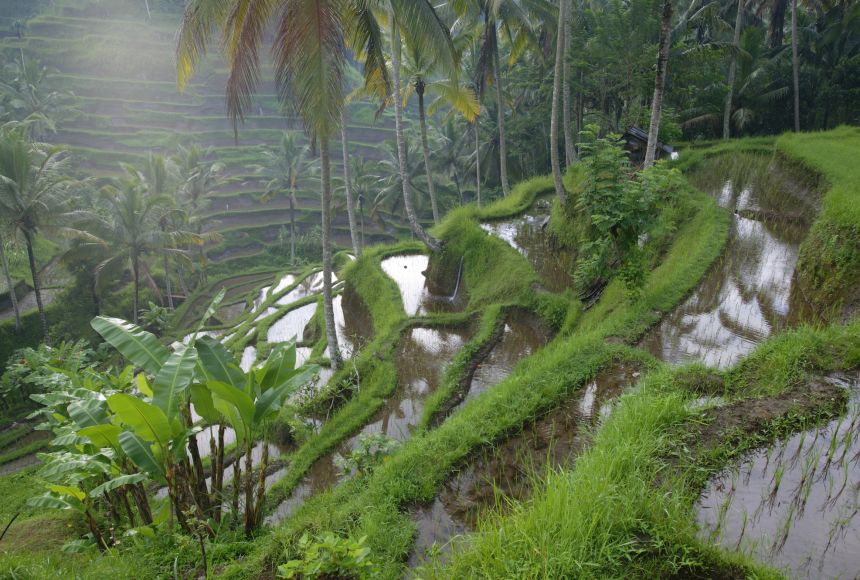Agricultural, or farming, methods have intensified continuously since the 18th century. The Industrial Revolution brought new equipment and farming methods that increased food production. In the mid-20th century, scientists discovered ways to produce stronger crops that produce more food, which increased crop harvests even further.
The increases in food production allowed the global population to grow quickly. In fact, it quadrupled in the past century. As the human population grew, so did the amount of space dedicated to feeding it. In 2016, more than seven million square kilometers (2.7 million square miles) were devoted to growing corn, wheat, rice, and other grains. That's nearly half of all cropland on the planet.
In the coming decades, however, feeding a growing population will likely be more difficult. Changing climates linked to Earth's warming are altering many of the natural processes that make modern agriculture possible.
Modern agriculture itself is also partly responsible for its problems. Farmers rely on many methods that are not sustainable. Farming sustainably means meeting the current needs without compromising the ability for future generations to meet their needs. Farmers often boost productivity in ways that also cause harmful effects on the environment. Below are brief descriptions of three ways intensive agriculture threatens ecosystems.
Irrigation
Agriculture accounts for 70 percent of freshwater use worldwide. Much of this water is used for irrigation, or the practice of watering crops through pipes, canals, and sprinklers. Irrigation is needed to support large harvests. Experts predict that agricultural water use may need to increase 15 percent or more by 2050 to feed the growing population.
Researchers and farmers are becoming more aware of the consequences of irrigation. One major consequence is the depletion of rivers and underground water systems; however, there are a number of other effects. When irrigation floods a particular area, the soil changes. It also creates conditions that poison plants' roots. When there is too little water in area, soils can become too salty, which also harms plant growth.
In addition, irrigation causes increases in water evaporation. This affects air temperature and pressure, as well as moisture conditions. Recent studies have confirmed that cropland irrigation can influence rainfall patterns—not only over irrigated areas but also thousands of kilometers away. Irrigation has also been connected to the erosion of coastlines.
Livestock Grazing
A huge amount of agricultural land is used for cattle and other livestock. In the western United States, hundreds of millions of acres are set aside for livestock grazing, which is when animals eat grass in pastures.
Livestock are responsible for a large proportion of global greenhouse gas emissions. Greenhouse gases trap heat in Earth's atmosphere, causing the planet to warm. Methane and carbon dioxide are two major greenhouse gases. Cows and their manure are responsible for releasing huge amounts of methane. Land use and destruction also lead to the release of carbon dioxide into the atmosphere.
In addition, overgrazing is a major problem for environmental sustainability. In some places, land is grazed so heavily that grasses are unable to grow back, and some native plants are so damaged that the species dies off. Cattle often concentrate near streams and other waterways. The combination of overgrazing and animal waste can pollute water sources. Cattle and other large grazing animals can even damage soil by trampling on it, destroying the top layer of soil and causing erosion.
Chemical Fertilizers
Modern agriculture has become heavily dependent on chemical fertilizers, which can help plants grow. The fertilizers usually contain nitrogen and phosphorus. They are particularly effective on corn, wheat, and rice crops. In large part, they are responsible for the explosive growth of grain cultivation in recent decades. China, with its rapidly growing population, has become the world's leading producer of nitrogen fertilizers.
Chemical fertilizers have helped double the rate of food production. They have also helped bring about a gigantic increase in nitrogen and phosphorus levels throughout the environment. These nutrients have become pollutants. Roughly half the nitrogen in chemical fertilizers escapes from the fields where it is applied. It finds its way into the soil, air, and water.
Large amounts of nitrogen and phosphorus harm ecosystems. Ecosystems can become loaded with too many nutrients—this process is called eutrophication. In water bodies, eutrophication can cause toxic algae, or water plants, to grow. When the algae decay, they consume oxygen in the water. This leaves little oxygen for other plants and animals in the water. These areas of little to no oxygen are called "dead zones" because organisms die without oxygen. Dead zones often occur in parts of the Gulf of Mexico.
As the population continues to grow, agricultural productivity and environmental health will clash. We will have to find ways to feed people without harming the ecosystems that we need for growing food.


